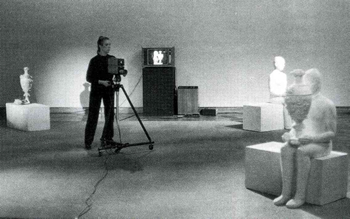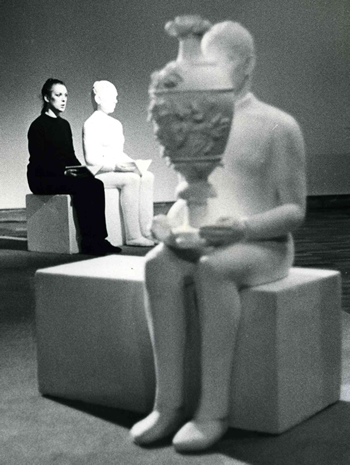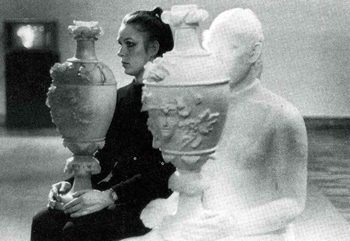“BEYOND STILL LIFE” 1980

ART PRESS The performance began with a recording describing the waiting audience; but this description was in the past tense. The artist, pre-recording in the recent past anticipated the now/our present as already in the past. Simultaneously, we were, and we are looking back at the unfolding present from the future. To the question of reality and mimesis was added a complex perspective of layered time.

As the performance continued, the recording revealed that the book and vase were the ones used by the artist for a still life many years ago. Using a camera, the artist produced on the monitor a flat picture as nearly as possible identical in appearance to the original painting. At this point we heard her recall her exact feelings when working on the painting. Later, the mode of still-life was explored: to the art historian still-life is a genre which can be appreciated technically, culturally as form, and also culturally in terms of the complex of significance historically attached to the depicted objects. The artist as composer/image maker must be competent and conversant with cultural languages. She knows the cultural significance of the objects: but their meanings to her are additionally loaded with contingencies of personal history and linked in her memory in ways which a painting could never reveal . . . The real artist picked up each item in turn, took it to a figure, and sat so that momentarily her image on the monitor merged with her replica. Then the real was exchanged for the copy, and the copy put in place in the still-life. Meanwhile, the memory of the items was told, adding layers of private and intense experience, and questions of reality proliferated.
Tam Giles, Primary Sources no 6, November 1980

Garrard took on both the role of Pandora and of the sculptor, enacting the role of subjection and ascribed culpability in counterpoint to the role of artist who seeks to carry her own history, and control her own image. The atmosphere of the piece, hushed and solemn, released a sense in the spectators that something was being ritually exorcised. The burden of Garrard's performance moved to affirmation and enablement for other women too, as she reworked patriarchal lore to incorporate it changed, into her personal mythology.
Marina Warner, 'Redressing the Balance', NGBK, Berlin, 1987
ART PRESS 'Beyond Still Life' (first performed as part of the women's exhibition 'About Time' at the ICA) was centred on a particular childhood occurrence - seeing her older brother kill a bird - that over-whelmed her capacity to express her feelings. In the tape accompanying the performance she says: "her anger will be seen as weakness . . . she is afraid that any expression of her feelings will invite attack. " Quietly she performed a compensatory gesture, placing the dead bird inside the house, next to a book and a vase which she was painting at the time, in an attempt to 'create a still life'. Memorial, act of transcendence, defusion, her desire for order becomes an archetypal act of feminine integration.
As counterpoint to this act of self-denial, interjected into the performance is a male voice reading the myth of Pandora "this first woman .. . a heart filled with lies and cunning words . . . brought pain and suffering to man. " Pandora, woman as made by man, becomes the base of male cultural hegenomy. Thus counterpoised with the idea of self-denial in the personal narrative, Garrard's use of the Pandora myth functions as a metaphor for the colonisation of female creativity. Hence her integration into the performance as an object within a still life - albeit that her role as performer is that of a manipulator of objects and coordinator of events - is a calculated attempt to position herself as a presence framed by the myth. What remains to be done, however, is to break down this framework; as she says in the text, it is necessary "to locate something beyond the still-life".
In this work Garrard is using her past as a source of fiction to be negotiated and transcended, an idea emphasised by the complementary use of myth. The myth of Pandora is not an arbitrary choice but a story avidly read and absorbed by the artist as a child; the recovery of the story determines a new reading, one that subverts and displaces the meanings formed by a younger self . . . Garrard's transformation of incidents from her life into narratives of patriarchy is an insistence on the need for new stories, stories that hold the possibility of creating new languages, new forms, new roles. As she has said, "the role models have yet to be created for women by women".
John Roberts, 'Between Ourselves', Ikon Gallery, Birmingham, 1984
SITES
'About Time' Institute of Contemporary Art London
Third Eye Centre Glasgow
COMPONENTS
First Pandora performance. Pre-recorded and live sound, central video camera on tripod, close-circuit to four monitors, four plinths with objects: the book, the vase, the bird and white plaster replicas. Three life size white seated figures. Artist performing in black and white clothing
CO-SELECTOR AND ORGANISER
'About Time' exhibition of time based work by 21 women artists as part of Womens Images of Men series.